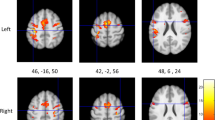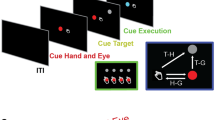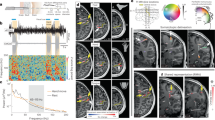Abstract
IN accordance with its important role in prehensile activity, a large cortical area is devoted to representation of the digits. Within this large cortical zone in the macaque somatosensory cortex, the complexity of neuronal receptive field characteristics increases from area 3b to areas 1 and 2 (refs 1–7). This increase in complexity continues into the upper bank of the intraparietal sulcus, where the somatosensory cortex adjoins the parietal association cortex. In this bank, callosal connections are much denser than in the more anterior part of this cortical zone8–17. We have now discovered a substantial number of neurons with receptive fields on the bilateral hands. It was previously thought that neuronal receptive fields were restricted to the contralateral side in this cortical zone. Neurons with bilateral receptive fields were not found after lesioning the postcentral gyrus in the contralateral hemisphere. The majority of these neurons had receptive fields of the most complex types, representing multiple digits, indicating that the interhemispheric transer of information occurs at higher levels of the hierarchical processing in each hemisphere.
This is a preview of subscription content, access via your institution
Access options
Subscribe to this journal
Receive 51 print issues and online access
$199.00 per year
only $3.90 per issue
Buy this article
- Purchase on Springer Link
- Instant access to full article PDF
Prices may be subject to local taxes which are calculated during checkout
Similar content being viewed by others
References
Hyvärinen, J. & Poranen, A. J. Physiol., Lond. 257, 199–227 (1978).
Iwamura, Y., Tanaka, M. & Hikosaka, O. Brain Res. 197, 516–520 (1980).
Iwamura, Y., Tanaka, M., Sakamoto, M. & Hikosaka, O. Expl Brain Res. 51, 315–326 (1983).
Iwamura, Y., Tanaka, M., Sakamoto, M. & Hikosaka, O. Expl Brain Res. 51, 327–337 (1983).
Iwamura, Y., Tanaka, M., Sakomoto, M. & Hikosaka, O. Expl Brain Res. 58, 400–411 (1985).
Iwamura, Y., Tanaka, M., Sakomoto, M. & Hikosaka, O. Expl Brain Res. 58, 412–420 (1985).
Iwamura, Y., Tanaka, M., Sakamoto, M. & Hikosaka, O. Expl Brain Res. 92, 360–368 (1993).
Jones, E. G. & Powell, T. P. S. Brain 92, 717–730 (1969).
Pandya, D. N. & Vigonolo, L. A. Brain Res. 15, 49–65 (1969).
Karol, E. A. & Pandya, D. N. Brain 94, 471–486 (1971).
Jones, E. G., Coulter, J. D. & Wise, S. P. J. comp. Neurol. 188, 113–136 (1979).
Jones, E. G. & Hendry, S. H. C. Neurosci. Lett. 19, 167–172 (1980).
Killackey, H. P., Gould, H. J., Cusick, C. G., Pons, T. P. & Kaas, J. H. J. comp. Neurol. 219, 384–419 (1983).
Shanks, M. F., Pearson, R. C. A. & Powell, T. P. S. Brain Res. Rev. 9, 43–65 (1985).
Caminiti, R. & Sbriccoli, A. J. comp. Neurol. 237, 85–99 (1985).
Manzoni, T., Barbaresi, F., Conti, P. & Fabri, M. Expl Brain Res. 76, 251–266 (1989).
Berlucchi, G. in Handbook of Neuropsychology (eds Boler, F. & Grafman, J.) 4, 9–46 (Elsevier, Amsterdam, 1990).
Pons, T. P., Garraghty, P. E., Cusick, C. G. & Kaas, J. H. J. comp. Neurol. 241, 445–466 (1985).
Powell, T. P. S. & Mountcastle, V. B. Bull. Johns Hopkins Hosp. 105, 108–131 (1959).
Seltzer, B. & Pandya, D. N. Expl Brain Res. 62, 459–469 (1986).
Duffy, F. H. & Burchfiel, J. L. Science 172, 273–275 (1971).
Sakata, H., Takaoka, Y., Kawarasaki, A. & Shibutani, H. Brain Res. 64, 85–102 (1973).
Mountcastle, V. B., Lynch, J. C., Georgopoulos, A., Sakata, H. & Acuna, C. J. Neurophysiol. 38, 871–908 (1975).
Burbaud, P., Doegle, C., Gross, C. & Bioulac, B. J. Neurophysiol. 66, 429–443 (1991).
Ebner, F. F. & Myers, R. E. J. Neurophysiol. 25, 380–391 (1962).
Hunter, M., Ettlinger, G. & Maccabe, J. J. Brain Res. 93, 223–240 (1975).
Ridley, R. M. & Ettlinger G. Expl Brain Res. 31, 475–488 (1978).
Pandya, D. N. & Seltzer, B. J. comp. Neurol. 204, 196–210 (1982).
Robinson, C. J. & Burton, H. J. comp. Neurol. 192, 43–67 (1980).
Robinson, C. J. & Burton, H. J. comp. Neurol. 192, 69–92 (1980).
Author information
Authors and Affiliations
Rights and permissions
About this article
Cite this article
Iwamura, Y., Iriki, A. & Tanaka, M. Bilateral hand representation in the postcentral somatosensory cortex. Nature 369, 554–556 (1994). https://doi.org/10.1038/369554a0
Received:
Accepted:
Issue Date:
DOI: https://doi.org/10.1038/369554a0
This article is cited by
-
Visual perceptual load and processing of somatosensory stimuli in primary and secondary somatosensory cortices
Scientific Reports (2023)
-
Emerging principles in functional representations of touch
Nature Reviews Psychology (2023)
-
Stimulus awareness is associated with secondary somatosensory cortex activation in an inattentional numbness paradigm
Scientific Reports (2023)
-
Local-to-distant development of the cerebrocerebellar sensorimotor network in the typically developing human brain: a functional and diffusion MRI study
Brain Structure and Function (2019)
-
Haptic shape discrimination and interhemispheric communication
Scientific Reports (2018)
Comments
By submitting a comment you agree to abide by our Terms and Community Guidelines. If you find something abusive or that does not comply with our terms or guidelines please flag it as inappropriate.



